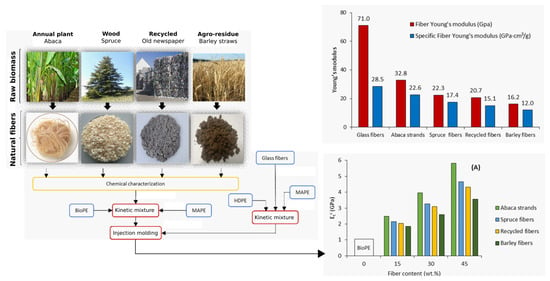Stiffening Potential of Lignocellulosic Fibers in Fully Biobased Composites: The Case of Abaca Strands, Spruce TMP Fibers, Recycled Fibers from ONP, and Barley TMP Fibers
Abstract
1. Introduction
2. Materials and Methods
2.1. Materials
2.2. Methods
2.2.1. Chemical Characterization of the Fibers
2.2.2. Composites Processing
2.2.3. Mechanical Test
2.2.4. Fibers Extraction from the Composites
2.2.5. Determination of Fiber Density and Volume Fractions
2.3. Micromechanics of Young’s Modulus
3. Results
3.1. Chemical Composition of the Fibers
3.2. Evaluation of Composites’ Stiffness
3.3. Contribution of Fibers to the Stiffness of Composites
3.4. Micromechanics of Young’s Modulus
3.5. Evaluation of the Longitudinal and Transverse Moduli
4. Conclusions
Author Contributions
Funding
Institutional Review Board Statement
Informed Consent Statement
Data Availability Statement
Acknowledgments
Conflicts of Interest
References
- Peças, P.; Carvalho, H.; Salman, H.; Leite, M. Natural Fibre Composites and Their Applications: A Review. J. Compos. Sci. 2018, 2, 66. [Google Scholar] [CrossRef]
- Faruk, O.; Bledzki, A.K.; Fink, H.P.; Sain, M. Biocomposites Reinforced with Natural Fibers: 2000–2010. Prog. Polym. Sci. 2012, 37, 1552–1596. [Google Scholar] [CrossRef]
- Lopez, J.P.; Méndez, J.A.; el Mansouri, N.-E.; Mutjé, P.; Vilaseca, F. Mean Intrinsic Tensile Properties of Stone Groundwood Fibers from Softwood. BioResources 2011, 6, 5037–5049. [Google Scholar]
- Mohanty, A.K.; Misra, M.; Drzal, L.T. Sustainable Bio-Composites from Renewable Resources: Opportunities and Challenges in the Green Materials World. J. Polym. Environ. 2002, 10, 19–26. [Google Scholar] [CrossRef]
- Koronis, G.; Silva, A.; Fontul, M. Green Composites: A Review of Adequate Materials for Automotive Applications. Compos. Part B Eng. 2013, 44, 120–127. [Google Scholar] [CrossRef]
- Holbery, J.; Houston, D. Natural-Fiber-Reinforced Polymer Composites in Automotive Applications. JOM 2006, 58, 80–86. [Google Scholar] [CrossRef]
- Delgado-Aguilar, M.; Vilaseca, F.; Tarrés, Q.; Julián, F.; Mutjé, P.; Espinach, F.X. Extending the Value Chain of Corn Agriculture by Evaluating Technical Feasibility and the Quality of the Interphase of Chemo-Thermomechanical Fiber from Corn Stover Reinforced Polypropylene Biocomposites. Compos. Part B Eng. 2018, 137, 16–22. [Google Scholar] [CrossRef]
- Vilaseca, F.; Valadez-Gonzalez, A.; Herrera-Franco, P.J.; Pèlach, M.À.; López, J.P.; Mutjé, P. Biocomposites from Abaca Strands and Polypropylene. Part I: Evaluation of the Tensile Properties. Bioresour. Technol. 2010, 101, 387–395. [Google Scholar] [CrossRef]
- Baley, C. Analysis of the Flax Fibres Tensile Behaviour and Analysis of the Tensile Stiffness Increase. Compos. Part A Appl. Sci. Manuf. 2002, 33, 939–948. [Google Scholar] [CrossRef]
- Espinach, F.X.; Julian, F.; Verdaguer, N.; Torres, L.; Pelach, M.A.; Vilaseca, F.; Mutje, P. Analysis of Tensile and Flexural Modulus in Hemp Strands/Polypropylene Composites. Compos. Part B Eng. 2013, 47, 339–343. [Google Scholar] [CrossRef]
- Syverud, K.; Chinga-Carrasco, G.; Toledo, J.; Toledo, P.G. A Comparative Study of Eucalyptus and Pinus Radiata Pulp Fibres as Raw Materials for Production of Cellulose Nanofibrils. Carbohydr. Polym. 2011, 84, 1033–1038. [Google Scholar] [CrossRef]
- Delgado-Aguilar, M.; Reixach, R.; Tarrés, Q.; Espinach, F.; Mutjé, P.; Méndez, J. Bleached Kraft Eucalyptus Fibers as Reinforcement of Poly(Lactic Acid) for the Development of High-Performance Biocomposites. Polymers 2018, 10, 699. [Google Scholar] [CrossRef]
- Serra-Parareda, F.; Tarrés, Q.; Delgado-Aguilar, M.; Espinach, F.X.; Mutjé, P.; Vilaseca, F. Biobased Composites from Biobased-Polyethylene and Barley Thermomechanical Fibers: Micromechanics of Composites. Materials 2019, 12, 4182. [Google Scholar] [CrossRef]
- Delgado-Aguilar, M.; Julián, F.; Tarrés, Q.; Méndez, J.A.; Mutjé, P.; Espinach, F.X. Bio Composite from Bleached Pine Fibers Reinforced Polylactic Acid as a Replacement of Glass Fiber Reinforced Polypropylene, Macro and Micro-Mechanics of the Young’s Modulus. Compos. Part B Eng. 2017, 125, 203–210. [Google Scholar] [CrossRef]
- López, J.P.; Mutjé, P.; Angels Pèlach, M.; el Mansouri, N.E.; Boufi, S.; Vilaseca, F. Analysis of the Tensile Modulus of Polypropylene Composites Reinforced with Stone Groundwood Fibers. BioResources 2012, 7, 1310–1323. [Google Scholar] [CrossRef]
- Delgado-Aguilar, M.; González, I.; Pèlach, M.A.; de La Fuente, E.; Negro, C.; Mutjé, P. Improvement of Deinked Old Newspaper/Old Magazine Pulp Suspensions by Means of Nanofibrillated Cellulose Addition. Cellulose 2015, 22, 789–802. [Google Scholar] [CrossRef]
- Vilaseca, F.; Méndez, J.A.; López, J.P.; Vallejos, M.E.; Barberà, L.; Pèlach, M.A.; Turon, X.; Mutjé, P. Recovered and Recycled Kraft Fibers as Reinforcement of PP Composites. Chem. Eng. J. 2008, 138, 586–595. [Google Scholar] [CrossRef]
- Serrano, A.; Espinach, F.X.; Tresserras, J.; del Rey, R.; Pellicer, N.; Mutje, P. Macro and Micromechanics Analysis of Short Fiber Composites Stiffness: The Case of Old Newspaper Fibers–Polypropylene Composites. Mater. Des. 2014, 55, 319–324. [Google Scholar] [CrossRef]
- Kuo, P.Y.; Wang, S.Y.; Chen, J.H.; Hsueh, H.C.; Tsai, M.J. Effects of Material Compositions on the Mechanical Properties of Wood-Plastic Composites Manufactured by Injection Molding. Mater. Des. 2009, 30, 3489–3496. [Google Scholar] [CrossRef]
- Serrano, A.; Espinach, F.X.; Tresserras, J.; Pellicer, N.; Alcala, M.; Mutje, P. Study on the Technical Feasibility of Replacing Glass Fibers by Old Newspaper Recycled Fibers as Polypropylene Reinforcement. J. Clean. Prod. 2014, 65, 489–496. [Google Scholar] [CrossRef]
- Reis, P.N.B.; Ferreira, J.A.M.; Silva, P.A.A. Mechanical Behaviour of Composites Filled by Agro-Waste Materials. Fibers Polym. 2011, 12, 240–246. [Google Scholar] [CrossRef]
- Flandez, J.; González, I.; Resplandis, J.B.; el Mansouri, N.-E.; Vilaseca, F.; Mutjé, P. Management of Corn Stalk Waste as Reinforcement for Polypropylene Injection Mouled Composites. BioResources 2012, 7, 1836–1849. [Google Scholar] [CrossRef]
- Rodriguez, M.; Rodriguez, A.; Bayer R., J.; Girones, J.; Vilaseca, F.; Mutjé, P. Determination of Corn Stalk Fibers’ Strength through Modeling of the Mechanical Properties of Its Composites. BioResources 2010, 5, 2535–2546. [Google Scholar]
- Serra-Parareda, F.; Tarrés, Q.; Espinach, F.X.; Vilaseca, F.; Mutjé, P.; Delgado-Aguilar, M. Influence of Lignin Content on the Intrinsic Modulus of Natural Fibers and on the Stiffness of Composite Materials. Int. J. Biol. Macromol. 2020. [Google Scholar] [CrossRef] [PubMed]
- Reixach, R.; Franco-Marquès, E.; el Mansouri, N.-E.; Ramirez de Cartagena, F.; Arbat, G.; Espinach, F.X.; Mutjé, P. Micromechanics of Mechanical, Thermomechanical, and Chemi-Thermomechanical Pulp from Orange Tree Pruning as Polypropylene Reinforcement: A Comparative Study. BioResources 2013, 8, 3231–3246. [Google Scholar] [CrossRef]
- Granda, L.A.; Espinach, F.X.; Méndez, J.A.; Tresserras, J.; Delgado-Aguilar, M.; Mutjé, P. Semichemical Fibres of Leucaena Collinsii Reinforced Polypropylene Composites: Young’s Modulus Analysis and Fibre Diameter Effect on the Stiffness. Compos. Part B Eng. 2016, 92, 332–337. [Google Scholar] [CrossRef]
- Sánchez-Gutiérrez, M.; Espinosa, E.; Bascón-Villegas, I.; Pérez-Rodríguez, F.; Carrasco, E.; Rodríguez, A. Production of Cellulose Nanofibers from Olive Tree Harvest—A Residue with Wide Applications. Agronomy 2020, 10, 696. [Google Scholar] [CrossRef]
- Domínguez-Robles, J.; Tarrés, Q.; Delgado-Aguilar, M.; Rodríguez, A.; Espinach, F.X.; Mutjé, P. Approaching a New Generation of Fiberboards Taking Advantage of Self Lignin as Green Adhesive. Int. J. Biol. Macromol. 2018, 108, 927–935. [Google Scholar] [CrossRef]
- Tarrés, Q.; Vilaseca, F.; Herrera-Franco, P.J.; Espinach, F.X.; Delgado-Aguilar, M.; Mutjé, P. Interface and Micromechanical Characterization of Tensile Strength of Bio-Based Composites from Polypropylene and Henequen Strands. Ind. Crop. Prod. 2019, 132, 319–326. [Google Scholar] [CrossRef]
- Domínguez-Robles, J.; Larrañeta, E.; Fong, M.L.; Martin, N.K.; Irwin, N.J.; Mutjé, P.; Tarrés, Q.; Delgado-Aguilar, M. Lignin/Poly(Butylene Succinate) Composites with Antioxidant and Antibacterial Properties for Potential Biomedical Applications. Int. J. Biol. Macromol. 2020, 145, 92–99. [Google Scholar] [CrossRef]
- Yang, H.S.; Wolcott, M.P.; Kim, H.S.; Kim, S.; Kim, H.J. Effect of Different Compatibilizing Agents on the Mechanical Properties of Lignocellulosic Material Filled Polyethylene Bio-Composites. Compos. Struct. 2007, 79, 369–375. [Google Scholar] [CrossRef]
- European Bioplastics & Nova-Institute. Bioplastics Market Data. 2019. Available online: Https://Www.European-Bioplastics.Org/Market/2019 (accessed on 18 February 2021).
- Siracusa, V.; Blanco, I. Bio-Polyethylene (Bio-PE), Bio-Polypropylene (Bio-PP) and Bio-Poly(Ethylene Terephthalate) (Bio-PET): Recent Developments in Bio-Based Polymers Analogous to Petroleum-Derived Ones for Packaging and Engineering Applications. Polymers 2020, 12, 1641. [Google Scholar] [CrossRef]
- Neagu, R.C.; Gamstedt, E.K.; Berthold, F. Stiffness Contribution of Various Wood Fibers to Composite Materials. J. Compos. Mater. 2006, 40, 663–699. [Google Scholar] [CrossRef]
- López, J.P.; Gironès, J.; Mendez, J.A.; Pèlach, M.A.; Vilaseca, F.; Mutjé, P. Impact and Flexural Properties of Stone-Ground Wood Pulp-Reinforced Polypropylene Composites. Polym. Compos. 2013, 34, 842–848. [Google Scholar] [CrossRef]
- Franco-Marquès, E.; Méndez, J.A.; Pèlach, M.A.; Vilaseca, F.; Bayer, J.; Mutjé, P. Influence of Coupling Agents in the Preparation of Polypropylene Composites Reinforced with Recycled Fibers. Chem. Eng. J. 2011, 166, 1170–1178. [Google Scholar] [CrossRef]
- Mutjé, P.; Vallejos, M.E.; Gironès, J.; Vilaseca, F.; López, A.; López, J.P.; Méndez, J.A. Effect of Maleated Polypropylene as Coupling Agent for Polypropylene Composites Reinforced with Hemp Strands. J. Appl. Polym. Sci. 2006, 102, 833–840. [Google Scholar] [CrossRef]
- Zabihzadeh, S.M.; Ebrahimi, G.; Enayati, A.A. Effect of Compatibilizer on Mechanical, Morphological, and Thermal Properties of Chemimechanical Pulp-Reinforced PP Composites. J. Thermoplast. Compos. Mater. 2011, 24, 221–231. [Google Scholar] [CrossRef]
- Granda, L.A.; Espinach, F.X.; López, F.; García, J.C.; Delgado-Aguilar, M.; Mutjé, P. Semichemical Fibres of Leucaena Collinsii Reinforced Polypropylene: Macromechanical and Micromechanical Analysis. Compos. Part B Eng. 2016, 91, 384–391. [Google Scholar] [CrossRef]
- Jiménez, A.M.; Delgado-Aguilar, M.; Tarrés, Q.; Quintana, G.; Fullana-i-Palmer, P.; Mutjé, P.; Espinach, F.X. Sugarcane Bagasse Reinforced Composites: Studies on the Young’s Modulus and Macro and Micro-Mechanics. BioResources 2017, 12, 3618–3629. [Google Scholar] [CrossRef]
- Nakamura, M.; Takahashi, H.; Hayakawa, I. Reinforcement of Denture Base Resin with Short-Rod Glass Fiber. Dent. Mater. J. 2007, 26, 733–738. [Google Scholar] [CrossRef]
- Mohanty, A.K.; Misra, M.; Drzal, L.T. Natural Fibers, Biopolymers, and Biocomposites; Taylor & Francis: Oxford, UK, 2005; ISBN 9780203508206. [Google Scholar]
- Hirsch, T.J. Modulus of Elasticity of Concrete Affected by Elastic Moduli of Cement Paste Matrix and Aggregate. J. Am. Concr. Inst. 1962, 59, 427–452. [Google Scholar]
- Chihaoui, B.; Serra-Parareda, F.; Tarrés, Q.; Espinach, F.X.; Boufi, S.; Delgado-Aguilar, M. Effect of the Fiber Treatment on the Stiffness of Date Palm Fiber Reinforced PP Composites: Macro and Micromechanical Evaluation of the Young’s Modulus. Polymers 2020, 12, 1693. [Google Scholar] [CrossRef]
- Kalaprasad, G.; Joseph, K.; Thomas, S.; Pavithran, C. Theoretical Modelling of Tensile Properties of Short Sisal Fibre-Reinforced Low-Density Polyethylene Composites. J. Mater. Sci. 1997, 32, 4261–4267. [Google Scholar] [CrossRef]
- Reixach, R.; Espinach, F.X.; Franco-Marquès, E.; Ramirez de Cartagena, F.; Pellicer, N.; Tresserras, J.; Mutjé, P. Modeling of the Tensile Moduli of Mechanical, Thermomechanical, and Chemi-Thermomechanical Pulps from Orange Tree Pruning. Polym. Compos. 2013, 34, 1840–1846. [Google Scholar] [CrossRef]
- Halpin, J.C.; Pagano, N.J. The Laminate Approximation for Randomly Oriented Fibrous Composites. J. Compos. Mater. 1969, 3, 720–724. [Google Scholar] [CrossRef]
- Halpin, J.C. Effects of Environmental Factors on Composite Materials; Air Force Materials Lab Wright-Patterson AFB: Montgomery, OH, USA, 1969. [Google Scholar]
- Cañigueral, N.; Vilaseca, F.; Méndez, J.A.; López, J.P.; Barberà, L.; Puig, J.; Pèlach, M.A.; Mutjé, P. Behavior of Biocomposite Materials from Flax Strands and Starch-Based Biopolymer. Chem. Eng. Sci. 2009, 64, 2651–2658. [Google Scholar] [CrossRef]
- Cox, H.L. The Elasticity and Strength of Paper and Other Fibrous Materials. Br. J. Appl. Phys. 1952, 3, 72–79. [Google Scholar] [CrossRef]
- Krenchel, H. Fibre Reinforcement; Theoretical and Practical Investigations of the Elasticity and Strength of Fibre-Reinforced Materials; Akademisk Forlag: Copenhagen, Denmark, 1964. [Google Scholar]
- Ververis, C.; Georghiou, K.; Christodoulakis, N.; Santas, P.; Santas, R. Fiber Dimensions, Lignin and Cellulose Content of Various Plant Materials and Their Suitability for Paper Production. Ind. Crop. Prod. 2004, 19, 245–254. [Google Scholar] [CrossRef]
- Khiari, R.; Mhenni, M.F.; Belgacem, M.N.; Mauret, E. Chemical Composition and Pulping of Date Palm Rachis and Posidonia Oceanica—A Comparison with Other Wood and Non-Wood Fibre Sources. Bioresour. Technol. 2010, 101, 775–780. [Google Scholar] [CrossRef]
- Fernando, D.; Hafrén, J.; Gustafsson, J.; Daniel, G. Micromorphology and Topochemistry of Extractives in Scots Pine and Norway Spruce Thermomechanical Pulps: A Cytochemical Approach. J. Wood Sci. 2008, 54, 134–142. [Google Scholar] [CrossRef]
- Vallejos, M.E.; Espinach, F.X.; Julián, F.; Torres, L.; Vilaseca, F.; Mutjé, P. Micromechanics of Hemp Strands in Polypropylene Composites. Compos. Sci. Technol. 2012, 72, 1209–1213. [Google Scholar] [CrossRef]
- Siregar, J.P.; Jaafar, J.; Cionita, T.; Jie, C.C.; Bachtiar, D.; Rejab, M.R.M.; Asmara, Y.P. The Effect of Maleic Anhydride Polyethylene on Mechanical Properties of Pineapple Leaf Fibre Reinforced Polylactic Acid Composites. Int. J. Precis. Eng. Manuf. Green Technol. 2019, 6, 101–112. [Google Scholar] [CrossRef]
- Keener, T.J.; Stuart, R.K.; Brown, T.K. Maleated Coupling Agents for Natural Fibre Composites. Compos. Part A Appl. Sci. Manuf. 2004, 35, 357–362. [Google Scholar]
- Adekomaya, O.; Adama, K. Glass-Fibre Reinforced Composites: The Effect of Fibre Loading and Orientation on Tensile and Impact Strength. Niger. J. Technol. 2017, 36, 782–787. [Google Scholar]
- Pimenta, M.T.B.; Carvalho, A.J.F.; Vilaseca, F.; Girones, J.; López, J.P.; Mutjé, P.; Curvelo, A.A.S. Soda-Treated Sisal/Polypropylene Composites. J. Polym. Environ. 2008, 16, 35–39. [Google Scholar] [CrossRef]
- Marques, G.; Rencoret, J.; Gutiérrez, A.; del Río, J.C. Evaluation of the Chemical Composition of Different Non-Woody Plant Fibers Used for Pulp and Paper Manufacturing. Open Agric. J. 2014, 4, 93–101. [Google Scholar] [CrossRef]
- Serrano, A.; Espinach, F.X.; Julian, F.; del Rey, R.; Mendez, J.A.; Mutje, P. Estimation of the Interfacial Shears Strength, Orientation Factor and Mean Equivalent Intrinsic Tensile Strength in Old Newspaper Fiber/Polypropylene Composites. Compos. Part B Eng. 2013, 50, 232–238. [Google Scholar] [CrossRef]
- López, J.P.; Boufi, S.; el Mansouri, N.E.; Mutjé, P.; Vilaseca, F. PP Composites Based on Mechanical Pulp, Deinked Newspaper and Jute Strands: A Comparative Study. Compos. Part B Eng. 2012, 43, 3453–3461. [Google Scholar] [CrossRef]
- Espinach, F.X.; Julián, F.; Alcalà, M.; Tresserras, J.; Mutjé, P. High Stiffness Performance Alpha-Grass Pulp Fiber Reinforced Thermoplastic Starch-Based Fully Biodegradable Composites. BioResources 2013, 9, 738–755. [Google Scholar] [CrossRef]
- Vilaseca, F.; Mendez, J.A.; Pèlach, A.; Llop, M.; Cañigueral, N.; Gironès, J.; Turon, X.; Mutjé, P. Composite Materials Derived from Biodegradable Starch Polymer and Jute Strands. Process. Biochem. 2007, 42, 329–334. [Google Scholar] [CrossRef]
- Oliver-Ortega, H.; Granda, L.A.; Espinach, F.X.; Delgado-Aguilar, M.; Duran, J.; Mutjé, P. Stiffness of Bio-Based Polyamide 11 Reinforced with Softwood Stone Ground-Wood Fibres as an Alternative to Polypropylene-Glass Fibre Composites. Eur. Polym. J. 2016, 84, 481–489. [Google Scholar] [CrossRef]
- González, I.; Alcalá, M.; Arbat, G.; Vilaseca, F.; Mutjè, P. Suitability of Rapeseed Chemithermomechanical Pulp as Raw Material in Papermaking. BioResources 2013, 8, 1697–1708. [Google Scholar] [CrossRef]
- Serra, A.; Tarrés, Q.; Chamorro, M.-À.; Soler, J.; Mutjé, P.; Espinach, F.X.; Vilaseca, F. Modeling the Stiffness of Coupled and Uncoupled Recycled Cotton Fibers Reinforced Polypropylene Composites. Polymers 2019, 11, 1725. [Google Scholar] [CrossRef] [PubMed]
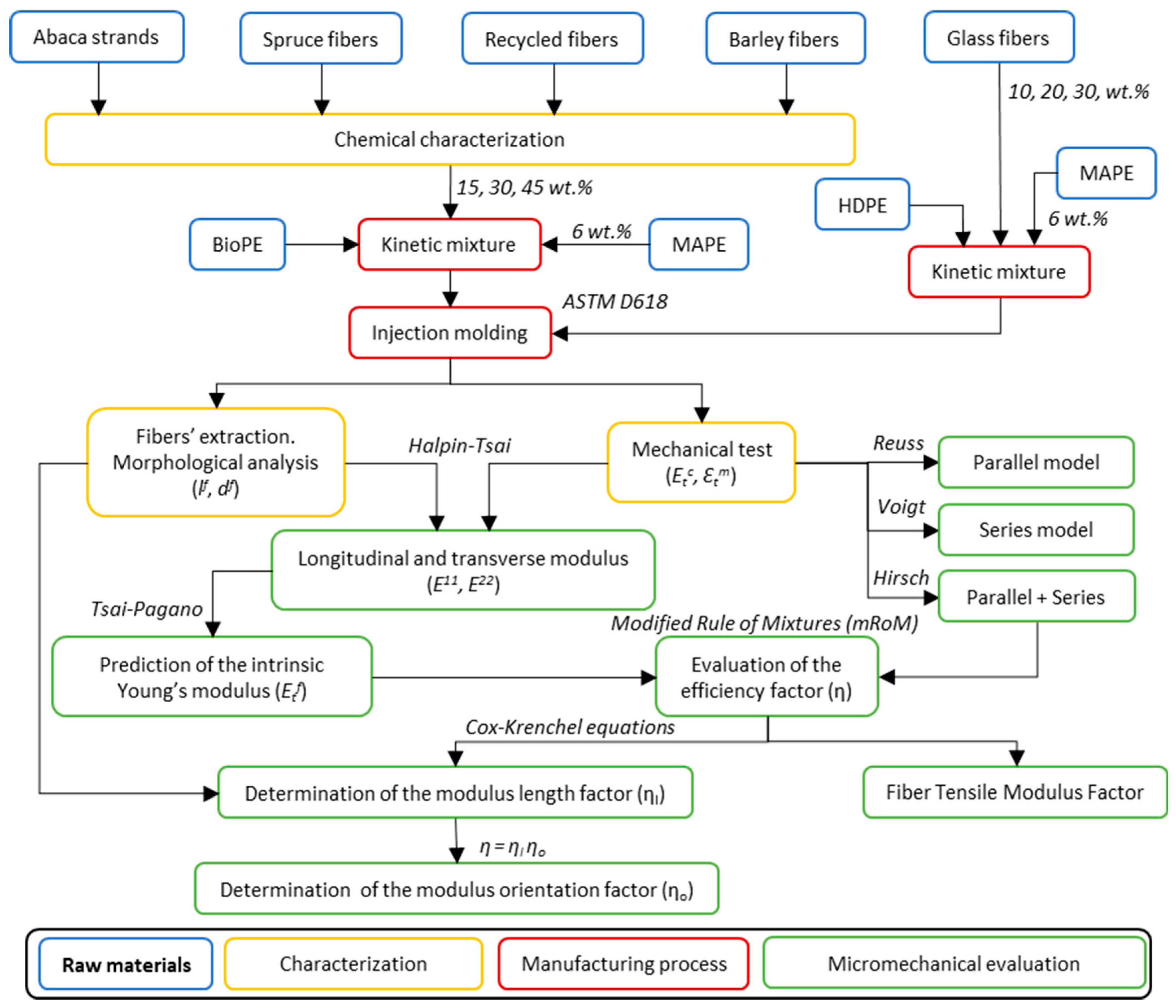
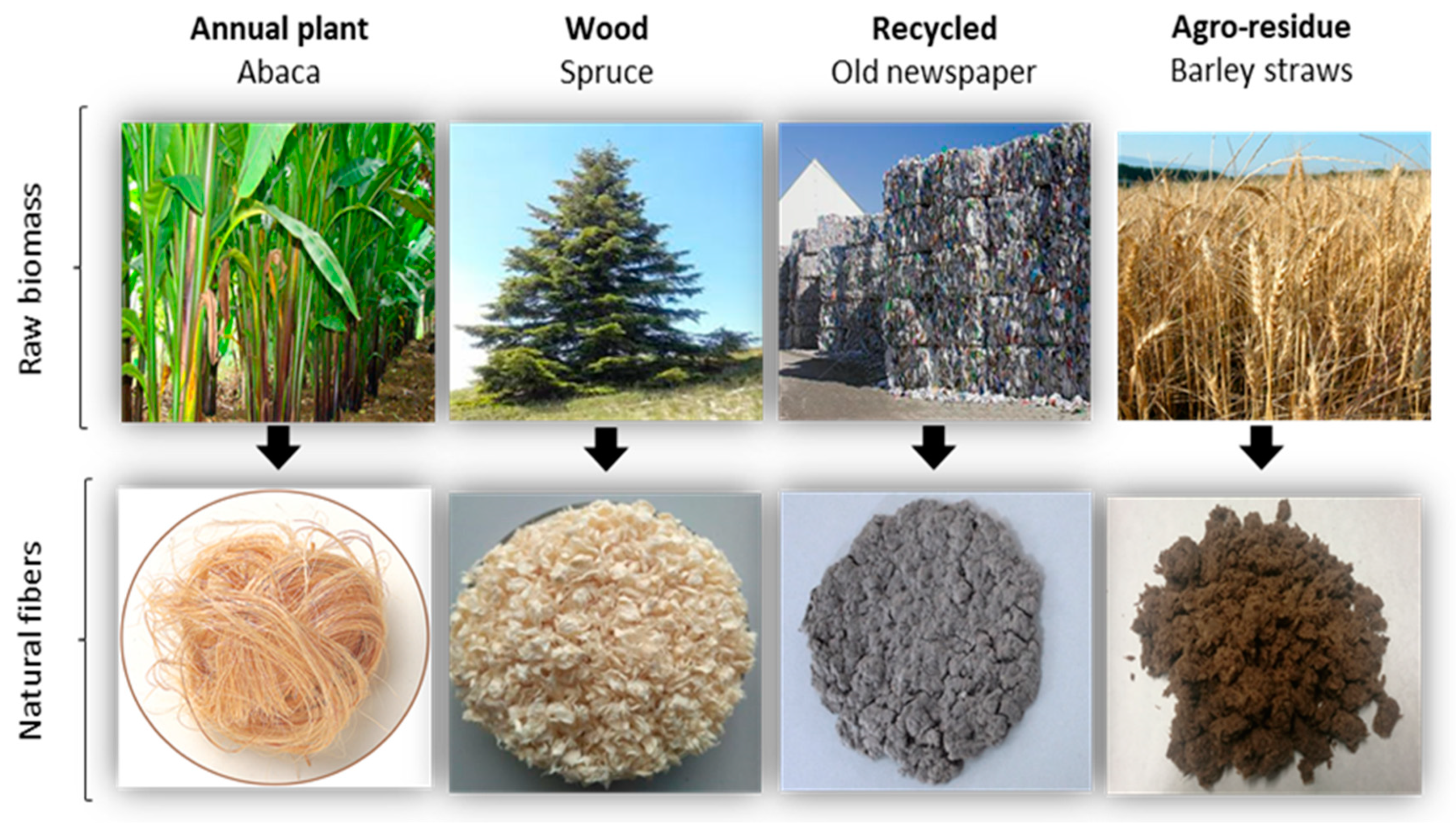

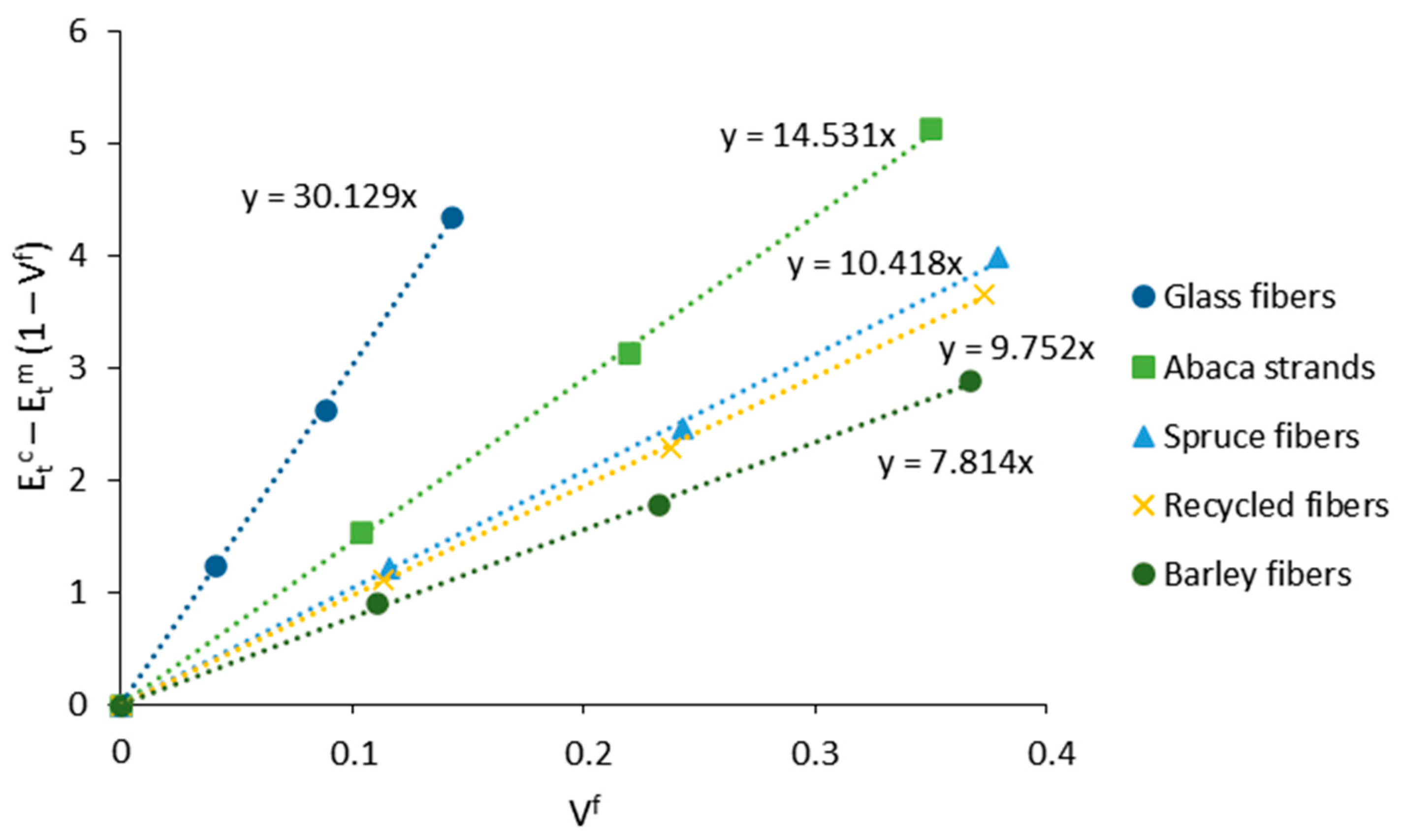
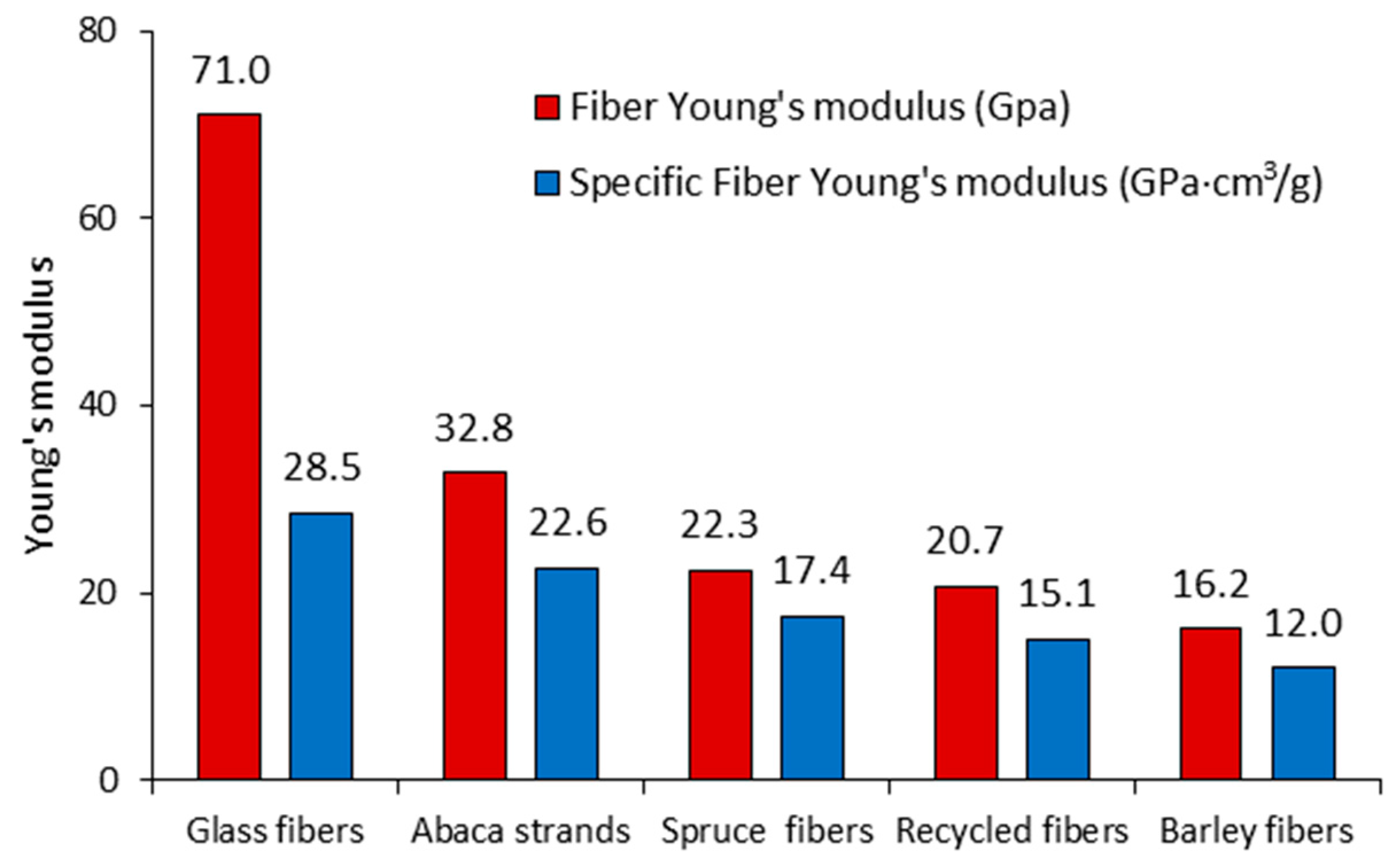
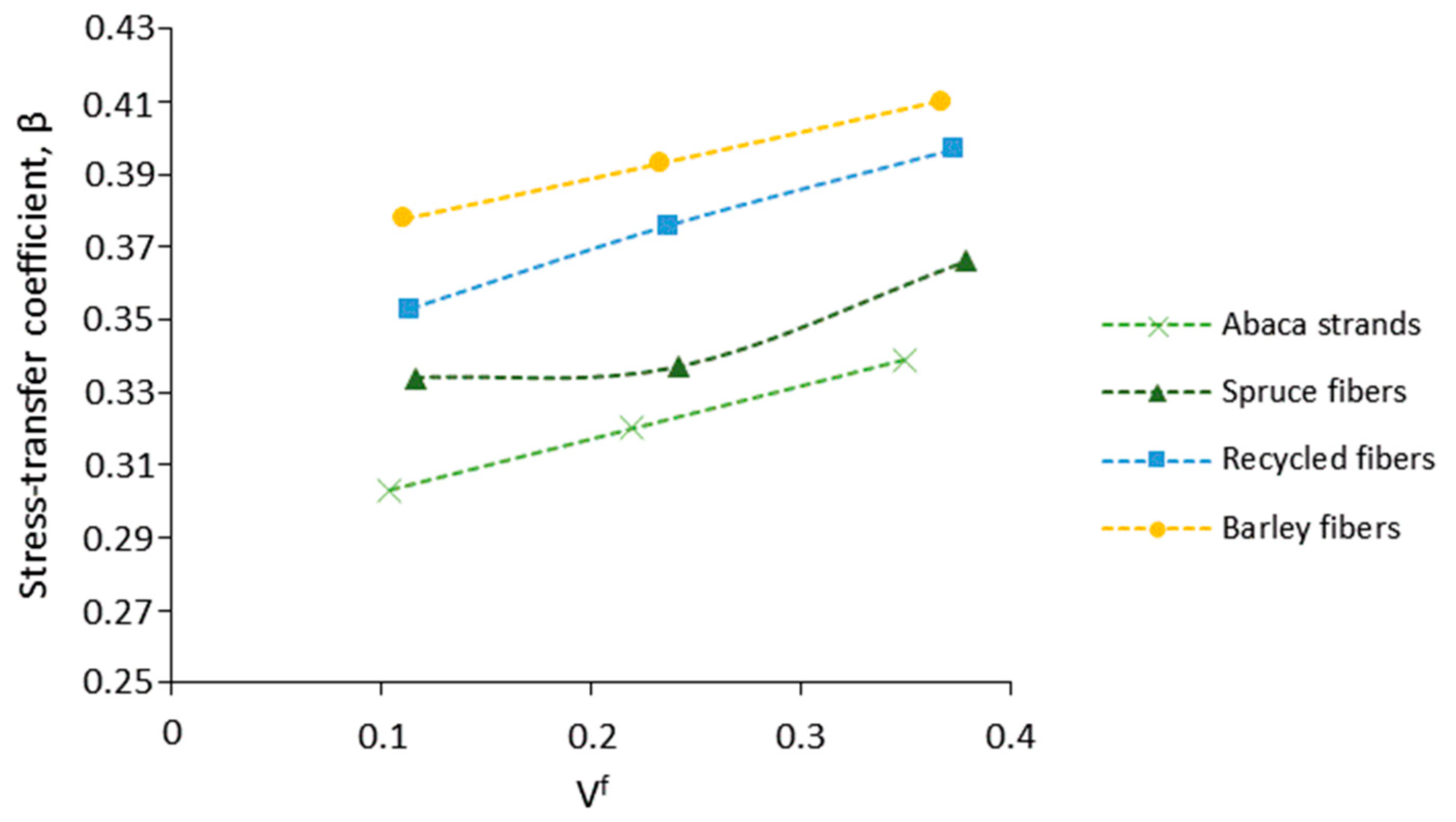
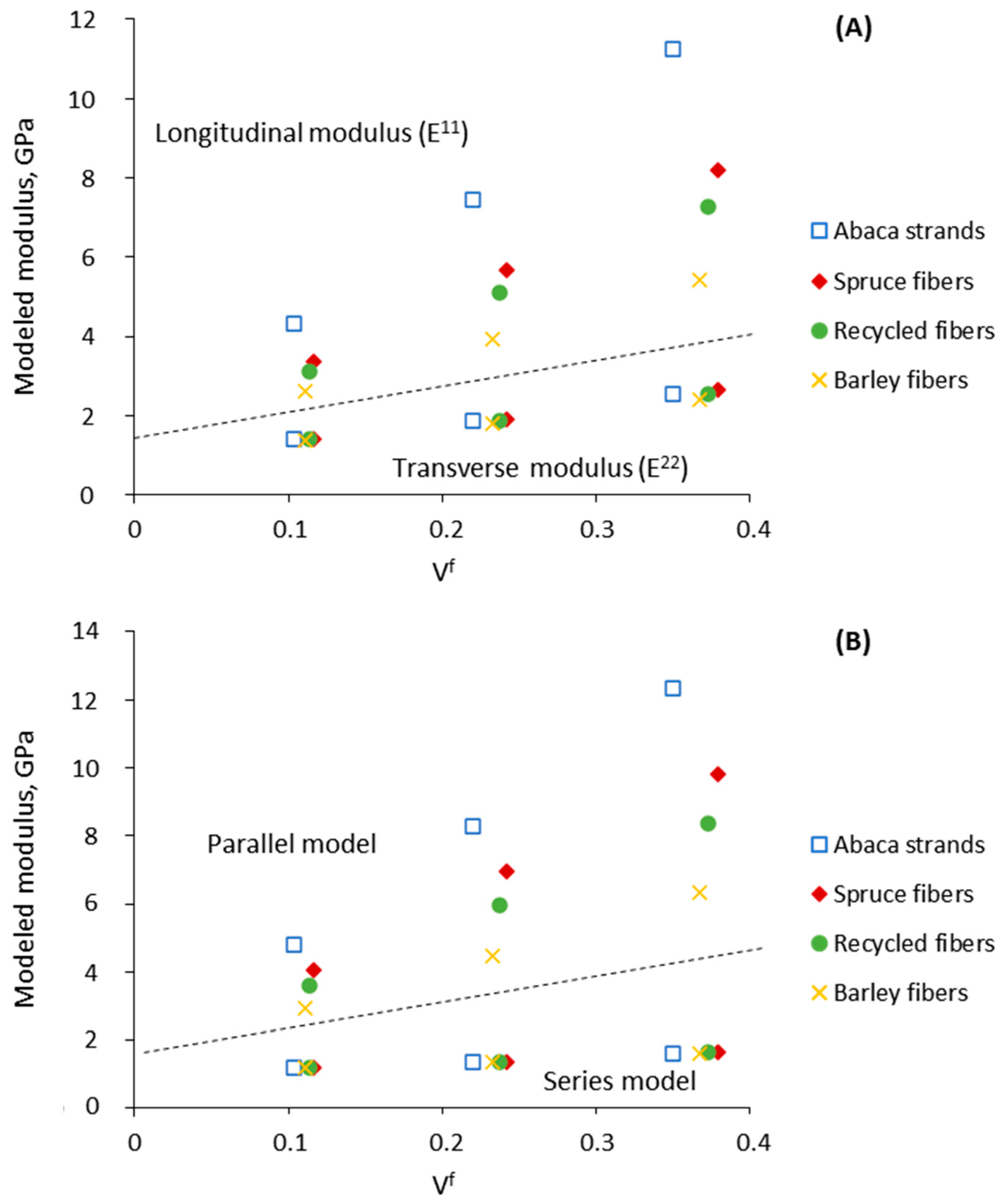
| Abaca Strands | Spruce Fibers | Recycled Fibers | Barley Fibers | |
|---|---|---|---|---|
| Holocellulose (wt.%) | 87.3 ± 0.6 | 73.7 ± 0.8 | 73.2 ± 0.8 | 77.7 ± 0.6 |
| Lignin (wt.%) | 8.9 ± 0.2 | 25.8 ± 0.2 | 20.4 ± 0.4 | 15.3 ± 0.5 |
| Extractives (wt.%) | 2.9 ± 0.2 | 0.3 ± 0.3 | 0.8 ± 0.1 | 2.7 ± 0.1 |
| Ashes (wt.%) | 0.9 ± 0.1 | 0.2 ± 0.2 | 5.6 ± 0.3 | 4.3 ± 0.3 |
| Matrix | Fiber Type | Fiber Content (wt.%) | ρc (g/cm3) | Vf (-) | Etc (GPa) | εtc (%) |
|---|---|---|---|---|---|---|
| BioPE | - | - | 0.96 | - | 1.06 ± 0.04 | 12.2 ± 0.2 |
| Abaca strands | 15 | 1.01 | 0.104 | 2.49 ± 0.11 | 7.1 ± 0.2 | |
| 30 | 1.06 | 0.220 | 3.96 ± 0.09 | 6.3 ± 0.3 | ||
| 45 | 1.13 | 0.350 | 5.81 ± 0.09 | 4.6 ± 0.2 | ||
| Spruce fibers | 15 | 0.99 | 0.116 | 2.15 ± 0.12 | 7.5 ± 0.1 | |
| 30 | 1.03 | 0.242 | 3.26 ± 0.13 | 6.3 ± 0.2 | ||
| 45 | 1.08 | 0.379 | 4.65 ± 0.07 | 4.9 ± 0.2 | ||
| Recycled fibers | 15 | 1.04 | 0.114 | 2.05 ± 0.09 | 5.2 ± 0.2 | |
| 30 | 1.08 | 0.237 | 3.09 ± 0.05 | 4.6 ± 0.3 | ||
| 45 | 1.14 | 0.373 | 4.32 ± 0.11 | 3.8 ± 0.1 | ||
| Barley fibers | 15 | 1.00 | 0.111 | 1.85 ± 0.04 | 7.7 ± 0.2 | |
| 30 | 1.05 | 0.233 | 2.59 ± 0.09 | 6.5 ± 0.3 | ||
| 45 | 1.10 | 0.367 | 3.55 ± 0.06 | 4.7 ± 0.2 | ||
| HDPE | - | - | 0.95 | - | 1.09 ± 0.03 | 11.1 ± 0.3 |
| Glass fibers | 10 | 1.01 | 0.041 | 2.25 ± 0.08 | 5.5 ± 0.2 | |
| 20 | 1.09 | 0.089 | 3.67 ± 0.13 | 4.6 ± 0.1 | ||
| 30 | 1.17 | 0.143 | 5.21 ± 0.14 | 3.2 ± 0.2 |
| Natural Fiber | Vf | lwf (µm) | df (µm) | Etf—Hirsch (GPa) | Etf—TP/HT (GPa) | Discrepancy (GPa) |
|---|---|---|---|---|---|---|
| Abaca strands | 0.104 | 1062 ± 32 | 22.3 ± 0.4 | 33.7 | 43.8 | 10.1 |
| 0.220 | 966 ± 24 | 22.6 ± 0.2 | 32.1 | 39.5 | 7.4 | |
| 0.350 | 917 ± 17 | 22.4 ± 0.1 | 32.7 | 38.0 | 5.3 | |
| Spruce fibers | 0.116 | 861 ± 26 | 25.2 ± 0.3 | 22.8 | 26.9 | 4.1 |
| 0.242 | 792 ± 37 | 25.7 ± 0.3 | 21.8 | 25.4 | 3.6 | |
| 0.379 | 743 ± 33 | 25.4 ± 0.4 | 22.4 | 24.2 | 1.8 | |
| Recycled fibers | 0.114 | 805 ± 41 | 21.4 ± 0.2 | 21.1 | 23.6 | 2.5 |
| 0.237 | 746 ± 27 | 21.3 ± 0.3 | 20.5 | 21.7 | 1.2 | |
| 0.373 | 684 ± 26 | 21.4 ± 0.2 | 20.6 | 20.7 | 0.1 | |
| Barley fibers | 0.111 | 596 ± 18 | 18.3 ± 0.1 | 17.2 | 18.1 | 0.9 |
| 0.233 | 503 ± 26 | 18.5 ± 0.2 | 15.6 | 15.8 | 0.2 | |
| 0.367 | 387 ± 21 | 18.7 ± 0.2 | 15.8 | 15.4 | -0.4 |
| Hirsch Model | TP/HT Model | ||||||
|---|---|---|---|---|---|---|---|
| Natural Fiber | Vf | η | ηl | ηo | η | ηl | ηo |
| Abaca strands | 0.104 | 0.44 | 0.91 | 0.48 | 0.34 | 0.89 | 0.38 |
| 0.220 | 0.44 | 0.92 | 0.48 | 0.36 | 0.92 | 0.39 | |
| 0.350 | 0.45 | 0.94 | 0.48 | 0.38 | 0.93 | 0.41 | |
| Spruce fibers | 0.116 | 0.46 | 0.90 | 0.51 | 0.39 | 0.89 | 0.43 |
| 0.242 | 0.47 | 0.92 | 0.51 | 0.40 | 0.91 | 0.44 | |
| 0.379 | 0.47 | 0.93 | 0.51 | 0.43 | 0.93 | 0.47 | |
| Recycled fibers | 0.114 | 0.46 | 0.90 | 0.52 | 0.41 | 0.91 | 0.46 |
| 0.237 | 0.47 | 0.91 | 0.51 | 0.44 | 0.93 | 0.48 | |
| 0.373 | 0.48 | 0.92 | 0.52 | 0.47 | 0.94 | 0.50 | |
| Barley fibers | 0.111 | 0.48 | 0.88 | 0.54 | 0.45 | 0.91 | 0.50 |
| 0.233 | 0.49 | 0.90 | 0.54 | 0.48 | 0.92 | 0.53 | |
| 0.367 | 0.49 | 0.90 | 0.55 | 0.51 | 0.92 | 0.55 | |
Publisher’s Note: MDPI stays neutral with regard to jurisdictional claims in published maps and institutional affiliations. |
© 2021 by the authors. Licensee MDPI, Basel, Switzerland. This article is an open access article distributed under the terms and conditions of the Creative Commons Attribution (CC BY) license (http://creativecommons.org/licenses/by/4.0/).
Share and Cite
Serra-Parareda, F.; Vilaseca, F.; Espinach, F.X.; Mutjé, P.; Delgado-Aguilar, M.; Tarrés, Q. Stiffening Potential of Lignocellulosic Fibers in Fully Biobased Composites: The Case of Abaca Strands, Spruce TMP Fibers, Recycled Fibers from ONP, and Barley TMP Fibers. Polymers 2021, 13, 619. https://doi.org/10.3390/polym13040619
Serra-Parareda F, Vilaseca F, Espinach FX, Mutjé P, Delgado-Aguilar M, Tarrés Q. Stiffening Potential of Lignocellulosic Fibers in Fully Biobased Composites: The Case of Abaca Strands, Spruce TMP Fibers, Recycled Fibers from ONP, and Barley TMP Fibers. Polymers. 2021; 13(4):619. https://doi.org/10.3390/polym13040619
Chicago/Turabian StyleSerra-Parareda, Ferran, Fabiola Vilaseca, Francesc X. Espinach, Pere Mutjé, Marc Delgado-Aguilar, and Quim Tarrés. 2021. "Stiffening Potential of Lignocellulosic Fibers in Fully Biobased Composites: The Case of Abaca Strands, Spruce TMP Fibers, Recycled Fibers from ONP, and Barley TMP Fibers" Polymers 13, no. 4: 619. https://doi.org/10.3390/polym13040619
APA StyleSerra-Parareda, F., Vilaseca, F., Espinach, F. X., Mutjé, P., Delgado-Aguilar, M., & Tarrés, Q. (2021). Stiffening Potential of Lignocellulosic Fibers in Fully Biobased Composites: The Case of Abaca Strands, Spruce TMP Fibers, Recycled Fibers from ONP, and Barley TMP Fibers. Polymers, 13(4), 619. https://doi.org/10.3390/polym13040619










